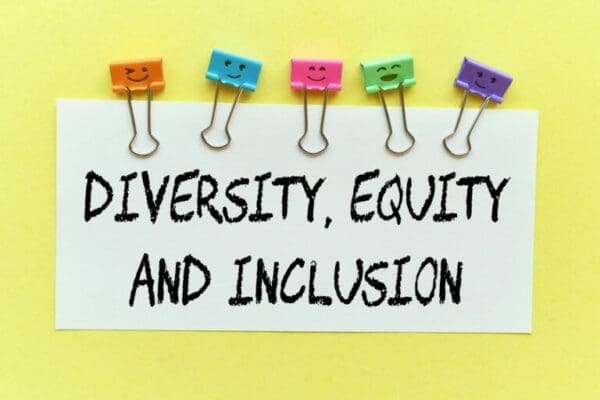ED&I – It’s the Ethical Way
Let Your Team Be Themselves and Shine
Equity, Diversity & Inclusion is a phrase we hear a lot in business. And over the next few years, it’s likely we’ll hear it even more.
ED&I has become the ‘thing’ it is now, in response to social change. As a result, progressive companies have realised that not only the workforce but consumers and customers have changed.
Businesses need to go with the flow and accept the new realities. It comes down to this. Embrace ED&I, or risk being left behind.
This article starts by exploring what Equity, Diversity & Inclusion is, and their different components. Specifically, we see why the equity part is important, and how a lack of ED&I can damage your people’s mental health. From there, we explore how to demonstrate ED&I, and the benefits it can bring to a business.
Is your workplace toxic? Well, we will also consider how to put it right. Lastly, we end with some ED&I conversation starter questions to start using today. Note that talking to your colleagues about all this is crucial. So, read this article to improve your chances of doing that.

>> Equality, Diversity and Inclusion Coaching Cards <<
First Question – What is Equity, Diversity & Inclusion?
In HR circles, the term Equity, Diversity & Inclusion – or Diversity, Equity & Inclusion, as it’s also known – describes policies and programmes that promote the representation of different groups in businesses.
In the UK, the Equality Act 2010 is specific about the protected characteristics it covers. These are age, disability, gender reassignment, marriage and civil partnership, pregnancy and maternity, race, religion or belief, sex, and sexual orientation. Discrimination on the grounds of any of these characteristics is illegal. HR departments, leadership, managers and team members alike need to be up to speed.

The 3 Components of ED&I:
Equity:
Equity in the workplace means readjusting organisational structures to allow for the disadvantages minority groups face.
Companies that adopt equity practices take individuals’ needs into consideration and help them move towards equal and just outcomes. They acknowledge we’re all different, and those differences make everyone great. And they make the business great, too.
Diversity:
This refers to how diverse a workforce is, in terms of people with different characteristics. But it’s not just about headcounts! Embracing diversity means welcoming different perspectives to a business.
It means appreciating that people aren’t defined by their specific characteristics and that everyone’s voice is unique. Achieving real diversity in a company requires a deeper understanding of every individual’s worth.
Inclusion:
This means ensuring every employee is given room to flourish and succeed. They have the chance to voice their opinions, based on their identities, and can see themselves reflected in the company’s values. Inclusion is the extent to which team members feel a sense of belonging and value.
Why is Equity Important In ED&I?
The key point here is that equity is empowering, giving everyone opportunities to advance in the business. People often talk about Diversity and Inclusivity, rather than Equity, Diversity & Inclusion. Unfortunately, that risks not giving equity its proper place in the scenario.
Yes, diversity and inclusivity promise identity safety for individuals who are different in some way from the rest of the workgroup. They can be their authentic selves, without the threat of discrimination or bullying.
This safeguarding aspect of diversity and inclusivity is extremely important. However, for these individuals to not just survive but also thrive, and for businesses to realise the commercial benefits of their presence, there also needs to be equity.
For companies, equity is a sound commercial proposition. Equitable employers outdo their less equitable competitors by respecting every team member’s unique needs, perspectives, and potential. They give everyone a chance to shine.
These companies earn deeper trust, commitment, and productivity. People stay longer, and it shows in the bottom line.

12 Benefits Equity, Diversity & Inclusion Can Bring to a Business
- Promote a shared experience for employees
- Provide broader perspectives
- Nurture a more positive workplace
- Understand customers better
- Add integrity to the team
- Put actions behind words
- Give opportunities to all
- Mirror the market
- Generate fresh insights
- Gain global appeal
- Encourage innovation
- Experience better staff retention
Supporting Neurodiversity in The Workplace
One positive recent development in UK businesses is increased support for neurodiversity. Differences from the normal in how a person processes information and learns are termed neurodiversity.
This includes autism, dyslexia, dyspraxia, ADHD, and other related differences. These differences can become highly disabling for the individuals concerned, as significant misunderstandings exist about the labels, and how they affect people.
How someone’s neurodiversity affects them can vary greatly. And for some, it may be regarded as a disability under the Equality Act 2010.
It’s your responsibility as an employer to make reasonable adjustments to support and enable neurodivergent employees. One way is to create a culture where people feel comfortable disclosing and talking openly about their diversity.
Lack of EDI Can Seriously Damage Your Mental Health.
Employees from diverse backgrounds or marginalised groups must deal with microaggressions, lack of representation, unconscious bias, and other stressors. Even more, negative experiences like sexism and harassment, racism, ableism, homophobia, and transphobia, impact people’s mental health and well-being.
Supporting DEI means ensuring employees have access to support from peers, leadership, support services and health providers.

How Do You Demonstrate Commitment to Equity, Diversity & Inclusion?
A company’s commitment to supporting ED&I is a major deciding factor for many candidates these days when they apply for jobs. Here are 10 ways your company can demonstrate commitment:
1. Be Open About Gender Pay Inequality:
Openness and honesty about your company’s gender pay gap inspire employees’ trust and respect. It demonstrates genuine concern about equity and a commitment to facing the problem.
2. Be Aware Of Unconscious Bias:
If you don’t explore and identify unconscious bias, diverse recruitment practices will be more of a problem. Is it endemic in your work culture? Make sure to take note of your managers’ and team leaders’ interactions with team members and subordinates.
Also, be aware of how much your workplace offers identity safety for individuals who are different from the rest of the group.
3. Acknowledge Religious and Cultural Holidays:
When employees feel supported, it leads to higher performance, better engagement and staff retention. Therefore taking a flexible approach and enabling employees to have days off for religious holidays and events demonstrates inclusion is a core value.
4. Encourage Frequent Employee Feedback:
One way to measure how inclusive your people consider your company to be is to be open to discussion and encourage employees to express their opinions. Particularly in larger companies, some will prefer to do this face-to-face, while others will prefer anonymous surveys or feedback forms. To fix the problems, first, you must know what they are.
5. Be Aware of Ageism and Strive for a Multi-generational Workforce:
People from different generations have varying world views, ways of working, core values, and experiences. And they all make for a more diverse workplace.

6. Have Strong Anti-discrimination Policies, and Enforce them When Needed
It’s important for employers to be approachable about the anti-discrimination measures in their workplace. One way to do this is to set these down in writing, audio, and braille, and make them publicly available.
Strong policies help employees experiencing discrimination feel confident discussing it with their manager, and feel safe and supported.
7. Celebrate Difference:
One of the most effective ways to nurture a commitment to inclusion is to celebrate differences and invite employees to take part. Here are some ways:
- Pride month celebrations
- Recognise significant calendar events like Black History Month and International Women’s Day. Get ideas from your team.
- Invest in prayer or meditation rooms or spaces. The Equality Act 2010 protects religious beliefs. It’s in employers’ best interests to support religious employees and enable them to bring their full selves to work.
8. Facilitate The Use of Pronouns:
Gender-inclusive language is an important part of demonstrating ED&I as a company value. Encourage employees and leadership to share their pronouns (she/her, he/him, they/them) on business cards, social media, and email signatures. You’re showing respect for individuals’ identities.
9. Identify and Eradicate Instances of Ableism:
This often falls under employers’ radar. Ableism assumes able-bodied people are superior to disabled people. This is what it looks like:
- Not providing adequate wheelchair access
- Ableist language in company policies
- Assuming disabled people lack bodily autonomy
- Providing inaccessible services
- Failing to comply with the Equality Act 2010
10. Taking Collective Responsibility:
Do this by holding each other and leadership responsible for implementing, seeing through, and striving to improve efforts.

That’s The Way to Do It! Try These Ways to Advance Equity in The Workplace:
- Accommodating health conditions or disabilities.
- Disclosing wage data.
- Having a hiring process where everyone has access to opportunities.
- Being aware of not only protected characteristics but also thinking beyond them.
- Promoting and supporting employee networks.
- Gathering, reporting, and acting on ED&I data.
Is Your Workplace Toxic?
Be aware of what’s happening. Here are 5 critical signs:
1. Communication:
In UK companies, when English isn’t an employee’s first language, language barriers can result. This leads to low morale and people feeling marginalised.
2. Harassment:
In a recent survey of Silicon Valley tech companies, where 7 out of 10 employees are men, 6 out of 10 women experienced gender discrimination and unwanted sexual advances. Two-thirds of this came from superiors. On the same note, women’s least common response was reporting it to HR or making a legal complaint. This was due to fear they wouldn’t be believed, there’d be no action, they’d be blamed, or there’d be retaliation. How are things in YOUR company?
3. Unconscious Bias:
Employers may discriminate against candidates for various reasons – their age, cultural background, gender, the way they dress, whatever it may be. If interviewers can’t identify this when they’re doing it, there’s not much they can do to prevent it.
4. Generation Gaps:
Different generations work differently. Communication styles, tech skills, work speeds, motivation and definitions of success all differ.
5. Diversity Without Inclusion:
Nothing is being done to foster inclusion between employees and bring them together to learn about each other.

ED&I By Numbers – Put These Ideas to Work Today
This is a huge topic, and an article like this can only prompt some thoughts. So the rest is down to you. Nonetheless, here are some more ideas you might find helpful:
6 Ways to Kickstart Equity, Diversity & Inclusivity in Your Business
- Redefine your culture and values.
- Practice inclusive hiring and promotion like you mean it.
- Have open dialogues about “taboo” topics.
- Invest in social impact funds and corporate social responsibility (CSR) programmes.
- Market your products, solutions or services to those who have been ignored.
- Rebuild your business to be a force for good.
6 Ways to Make Interviews More Inclusive
- Write job descriptions in inclusive language.
- Educate interviewers on the benefits of diverse teams, to counter the “just like me” bias.
- Standardise video interviews.
- Select questions that focus on capabilities.
- Ask all candidates the same questions.
- Use work samples to assess skills fairly.
11 Ways to Personally Support ED&I
- Know your company’s diversity goals and vision, and how it connects to the overall business objectives. Moreover, commit to the process by understanding how diversity affects your role, and your role impacts the initiative’s success.
- Participate in employee engagement surveys and respond as openly and honestly as possible.
- Actively engage in the diversity effort. You can do this by taking part in or starting an employee resource group. Also, you can volunteer to lead, or serve on, committees that organise diversity-related events and activities, and consider being a mentor, mentee, or co-mentor.
- Become culturally competent. Take time to know all you can about people’s cultures, races, religions, and backgrounds. One way to do this is to ask them to share their customs and practices.
- Become familiar with diversity-related terms. If you make a mistake, apologise, and ask for help.
- Treat people in a way THEY wish to be treated, rather than how you wish to be treated. Behaviour that’s comfortable for you, may not be for others. So, don’t tell jokes that may alienate people who are different from you.
- Drive positive change in the organisation. Be a spokesperson for diversity issues that aren’t necessarily your own. It’s hard to ignore the powerful voice that comes when groups unite, representing different diversity dimensions.
- Welcome ideas that are different from yours, and support fellow teammates. The creativity this sparks can help generate new ideas and improve existing arrangements. It can also make work more interesting and fun.
- Understand the diversity elements YOU bring to the conversation. Diversity comes in all kinds of ways. Each of us brings a lifetime of experience and knowledge.
- Commit to continuous improvement. Be willing to learn, accept feedback, and listen to the concerns of those around you. Everyone can find ways to do things better.
- Communicate and educate: Be tolerant of co-workers who don’t fully appreciate the value of diversity, or behave disrespectfully. Remember, diversity work doesn’t happen overnight. Like any sort of strategic leadership, you’re in it for the long term.
FINALLY: It’s an Ongoing Conversation

Here are some questions to help start your conversations about ED&I with colleagues:
- What does ED&I mean to YOU, and why do you think it’s important?
- How would you react, to hearing a co-worker say something inappropriate?
- Have you received any diversity training, and how have you applied it?
- In your role, how do you keep your biases in check?
- How do you approach understanding the point of view of co-workers from different backgrounds?
- Also, can you tell me about a time when you personally advocated for ED&I in the workplace?
- How would you approach a conversation with a colleague who doesn’t understand the importance of ED&I?
- How do you make sure your team feel a sense of inclusion and belonging?
All your efforts on equity, diversity and inclusion must serve to increase your people’s sense of acceptance. The level of inclusion they feel in their environment is what gives them their sense of belonging, and their commitment to giving their best.
Paying attention to ED&I will transform your employee experience and make your business great.



